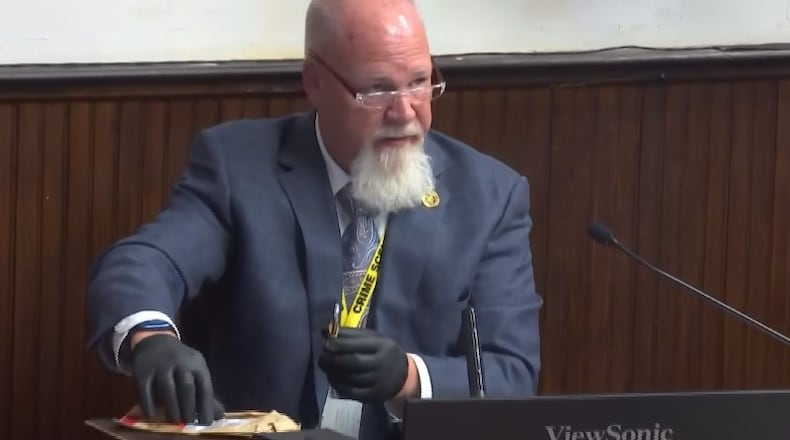WATCH LIVE:
Those found dead include:
- Christopher Rhoden Sr., 40
- Dana Rhoden, 37
- Hannah “Hazel” Gilley, 20
- Christopher Rhoden Jr., 16
- Clarence “Frankie” Rhoden, 20
- Gary Rhoden, 37
-Hanna May Rhoden, 19
- Kenneth Rhoden, 44
Wagner’s trial is the first time a person has faced a jury for the deaths. Monday’s proceedings included testimony from BCI investigator George Edward Staley, who talked about the death of Kenneth Rhoden, which occurred at the fourth crime scene.
Kenneth Rhoden was the final victim found. He wasn’t located until family members went to his home to tell him of the other murders.
Kenneth Rhoden’s son, Luke, testified during Week 1 of the trial, along with Donald Stone, a cousin and the person who first found Kenneth Rhoden’s body.
Staley told the court he started his investigation by photographing the property, working from the road to the camper in which Kenneth Rhoden resided. He noted three cameras mounted around the outside of a shed nearby, but the search revealed those cameras were not connected to anything.
Stairs heading down into an underground basement to the shed led Staley to a marijuana grow room, he testified. Staley said there was no evidence of forced entry into the shed.
Staley also said despite there being a working motion detector on the property, Kenneth Rhoden did not appear to have been awakened before being shot to death that night. There were no signs of struggle, he said.
Kenneth Rhoden has been shot through his eye while lying on his back on a bed, Staley told the courtroom.
“In my opinion, that was the position that he was shot,” he said.
Other details from the courtroom
- Prosecutors announced that investigators did not locate or process any evidence containing the DNA of Angela, Jake, Billy or George Wagner. This means DNA from the Wagner family has not been found at any of the four crime scenes in which eight members of the Rhoden family were found dead in 2016.
- Prosecutors re-called Dr. Karen Looman, the chief deputy coroner with the Hamilton County Coroner’s Office, to talk about Kenneth’s autopsy; Looman performed the autopsies for each member of the Rhoden family found dead. Before questioning Looman on Kenneth’s autopsy, Prosecutor Rob Junk circled back to one of the victims Looman already testified about: Hanna May. The 20-year-old had a mark on the back of her head that was consistent with her head being pressed against a hard surface, Looman said. There was a bar above her head on her bedframe that matched the mark made; Looman said if Hanna May had been alive, that mark would have eventually gone away, but because she was already dead when it pressed on her head, the mark remained. A brown color to the mark also indicated she was dead when the mark was made, Looman said. The mark could have happened because, after being killed, her body rested back against the bar, Looman said. During cross-examination, attorney John Parker asked if that mark could have been made because Hanna May’s body was re-arranged after she was killed; Looman said it was possible. During opening statements, Special Prosecutor Angie Canepa said George’s brother, Jake Wagner, admitted to moving Hanna May’s body so her days-old baby, whom she was nursing when she was shot, could continue to breastfeed.
- Toxicology testing revealed Kenneth Rhoden only had caffeine in his system when he was killed — a detail he shares with six other members of the family killed. Gary Rhoden tested positive for the presence of cocaine, but no other family member has had a substance other than caffeine present.
- BCI agent Matt White, a firearms examiner with the state agency, was the expert who examined and identified much of the ballistic evidence collected in all four crime scenes and during all eight autopsies. In testimony Monday, White began by describing the anatomy of a bullet and a gun to the jury and explaining the differences between a center-fired bullet and a rim-fired one. Prosecution also questioned him on the differences between several firearms, including a .40 Glock pistol, a .22 Walther Colt pistol and an SKS rifle — all weapons Canepa claimed the Wagner family used the night of the murders. Prosecution then led him through each crime scene and each piece of ballistic evidence collected from the autopsies; White identified three different kinds of bullets.
The trial of George Wagner IV is expected to last several weeks.
WCPO is covering the trial from the courtroom and is a content partner of Cox First Media.
About the Author


